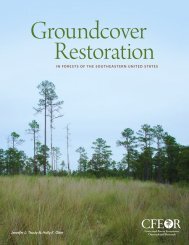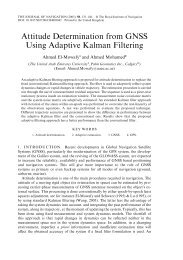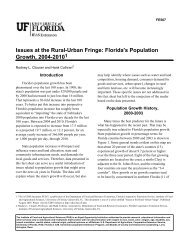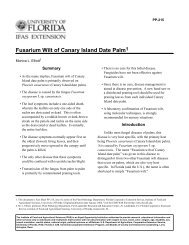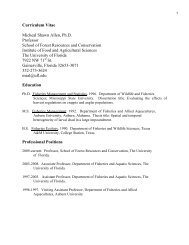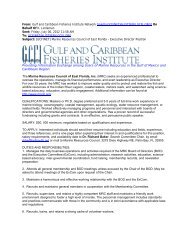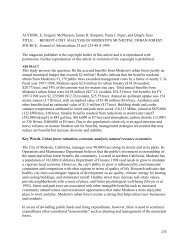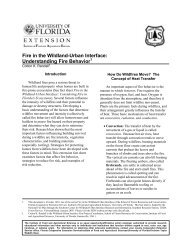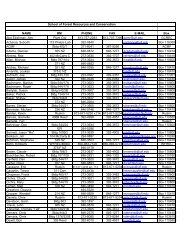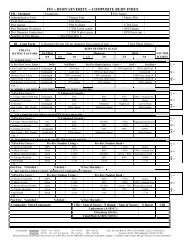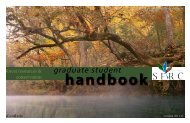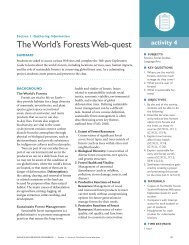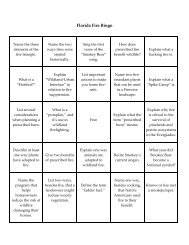Longleaf Pine Forest Restoration & Management - School of Forest ...
Longleaf Pine Forest Restoration & Management - School of Forest ...
Longleaf Pine Forest Restoration & Management - School of Forest ...
You also want an ePaper? Increase the reach of your titles
YUMPU automatically turns print PDFs into web optimized ePapers that Google loves.
FOR125<br />
Controlling Hardwoods in <strong>Longleaf</strong> <strong>Pine</strong> <strong>Restoration</strong> 1<br />
Patrick J. Minogue, Kimberly Bohn, and Rick Williams 2<br />
Historically in the longleaf pine (Pinus palustris)<br />
ecosystem, periodic fires ignited by lightning during<br />
the growing season fostered a relatively stable<br />
community characterized by widely spaced,<br />
uneven-aged pines and an understory dominated by<br />
bunch grasses and a diversity <strong>of</strong> forbs (broad-leaved<br />
plants that <strong>of</strong>ten produce seed favored by wildlife)<br />
(Platt et al. 1988; Noss 1989) (Figure 1). Many game<br />
species such as deer, turkey, and quail; as well as<br />
some endangered species such as red-cockaded<br />
woodpecker; threatened species such as gopher<br />
tortoise; and species <strong>of</strong> special concern such as<br />
Shermans fox squirrel and Florida mouse; all prefer<br />
the habitat <strong>of</strong> a relatively open pine overstory, no<br />
midstory, and a grassland understory. The plant<br />
communities <strong>of</strong> the longleaf pine savannah contain<br />
few shrubs or hardwood trees because native bunch<br />
grasses such as wiregrass (Aristida stricta) and<br />
broomsedge (Andropogon spp.) facilitate the ignition<br />
and spread <strong>of</strong> surface burns during the growing<br />
season, limiting the development <strong>of</strong> all but the most<br />
fire-tolerant hardwood species such as bluejack oak<br />
(Quercus incana) and turkey oak (Quercus laevis)<br />
(Landers 1991). Like longleaf pine, these bunch<br />
grasses are resilient to fire, and fires during the<br />
growing season induce them to produce abundant and<br />
viable seed, supporting wildlife and the proliferation<br />
<strong>of</strong> the ecosystem. With the exclusion <strong>of</strong> fire, these<br />
communities succeed to hardwood forests which are<br />
characterized by higher shading, greater litter<br />
accumulation, and less herbaceous ground cover. In<br />
the absence <strong>of</strong> management, shrubs and oak<br />
hardwoods will slowly encroach into the midstory,<br />
creating unfavorable conditions for groundcover and<br />
many wildlife species' wildlife habitat. <strong>Restoration</strong><br />
<strong>of</strong> longleaf stands that have been unmanaged for long<br />
periods will require additional investments to restore<br />
the appropriate species composition and structure.<br />
We have several tools available, used alone or in<br />
combination, to manage the hardwood component <strong>of</strong><br />
longleaf stands including:<br />
• tree felling<br />
• machinery<br />
• fire<br />
• herbicides<br />
Tree Felling – Cutting down individual trees is<br />
an option but this treatment alone will give rise to<br />
additional sprouting stems around the stump and<br />
1. This document is FOR125, one <strong>of</strong> a series <strong>of</strong> the <strong>School</strong> <strong>of</strong> <strong>Forest</strong> Resources and Conservation Department, Florida Cooperative Extension Service,<br />
Institute <strong>of</strong> Food and Agricultural Sciences, University <strong>of</strong> Florida. Original publication date August 3, 2007. Visit the EDIS Web Site at<br />
http://edis.ifas.ufl.edu.<br />
2. Patrick (Pat) Minogue is an Assistant Pr<strong>of</strong>essor <strong>of</strong> Silviculture with the University <strong>of</strong> Florida, North Florida Research and Education Center, 155 Research<br />
Road, Quincy, FL 32351. Drs. Kimberly Bohn, Assistant Pr<strong>of</strong>essor and Rick Williams, Associate Pr<strong>of</strong>essor, University <strong>of</strong> Florida, West Florida Research<br />
and Education Center, Milton, Florida.<br />
The Institute <strong>of</strong> Food and Agricultural Sciences (IFAS) is an Equal Opportunity Institution authorized to provide research, educational information and<br />
other services only to individuals and institutions that function with non-discrimination with respect to race, creed, color, religion, age, disability, sex,<br />
sexual orientation, marital status, national origin, political opinions or affiliations. U.S. Department <strong>of</strong> Agriculture, Cooperative Extension Service,<br />
University <strong>of</strong> Florida, IFAS, Florida A. & M. University Cooperative Extension Program, and Boards <strong>of</strong> County Commissioners Cooperating. Larry<br />
Arrington, Dean



